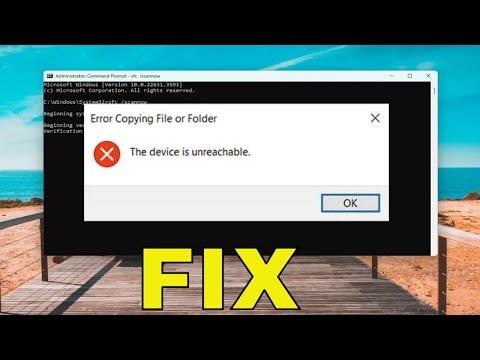I was in the middle of a critical project, working on a presentation due the next morning, when I encountered an issue that nearly derailed everything. I was transferring some important files from my external hard drive to my Windows 11 PC when suddenly an error message popped up: “Error 0x80070141, the Device Is Unreachable.” At first, I thought it might be a temporary glitch, so I tried reconnecting the external drive and restarting my computer, but nothing changed. This error persisted, and it seemed like my files were trapped on that external device.
As someone who relies heavily on my external drive for backups and file transfers, this was a serious problem. I had no idea what could be causing the issue, and the stress of a looming deadline made the situation even more urgent. I decided to take a systematic approach to troubleshoot and resolve this problem. Here’s what I did to get everything back on track.
First, I checked the physical connections. I made sure the external drive was properly connected to the USB port and that there were no loose cables. I also tried different USB ports on my PC to see if the issue might be with a particular port. When that didn’t help, I inspected the USB cable itself for any visible damage. Sometimes, a faulty cable can cause connection issues, and replacing it could resolve the problem.
Next, I tried connecting the external drive to another computer. This step was crucial because it helped me determine if the issue was with the drive itself or with my PC. When I plugged the drive into another computer, it was recognized immediately, and I could access all my files without any issues. This confirmed that the drive was functioning correctly, ruling out a hardware fault with the external device.
Since the problem seemed specific to my Windows 11 PC, I shifted my focus to software and system issues. I started by checking for any pending Windows updates. Sometimes, system updates can include important fixes for bugs and connectivity issues. I went to Settings > Update & Security > Windows Update and clicked on “Check for updates.” Fortunately, there were a few updates pending, so I installed them and restarted my PC.
Even after updating Windows, the error persisted. I decided to explore potential driver issues. I went to Device Manager by right-clicking on the Start menu and selecting it from the list. In Device Manager, I expanded the “Disk drives” section and found my external drive listed there. I right-clicked on it and selected “Update driver” to ensure that I had the latest drivers installed. I also checked the “Universal Serial Bus controllers” section for any USB-related issues and updated drivers for those as well.
Despite these efforts, the problem continued. I started looking into file system errors and corruption issues that might be causing the problem. I ran the built-in Windows troubleshooter for hardware and devices. To do this, I went to Settings > Update & Security > Troubleshoot > Additional troubleshooters, and selected “Hardware and Devices.” This troubleshooter scanned for issues and attempted to resolve any problems it detected.
When the troubleshooter didn’t fix the problem, I decided to run a few more diagnostic tools. I opened Command Prompt as an administrator and ran the System File Checker (SFC) by typing sfc /scannow. This command scans for corrupted system files and attempts to repair them. I also used the Deployment Imaging Service and Management Tool (DISM) by typing DISM /Online /Cleanup-Image /RestoreHealth. DISM helps repair the Windows image and can fix issues that SFC might not address.
After running these commands, I rebooted my computer and checked the external drive again. The error message was still there. At this point, I considered that the problem might be related to specific settings or configurations on my PC. I went to the Windows Security settings and checked for any security features or firewall rules that might be blocking the drive. I temporarily disabled the firewall and antivirus software to see if they were causing the issue, but the error message remained.
As a last resort, I decided to perform a clean boot of Windows. This process starts Windows with a minimal set of drivers and startup programs, which can help identify if background applications or services are causing conflicts. I followed the instructions to perform a clean boot: I opened the System Configuration tool by typing msconfig in the Run dialog, selected the “Selective startup” option, and disabled all startup items. After restarting my PC, I tested the external drive again. To my relief, the drive was now accessible without any errors.
With the clean boot method resolving the issue, I knew that one of the disabled services or startup programs was causing the conflict. I re-enabled the startup items and services one by one to pinpoint the exact cause. It turned out that a third-party security application was causing the problem. I reconfigured the settings of this application to ensure it wouldn’t interfere with my external drive, and the issue was resolved.
In the end, I was able to complete my project on time. This experience taught me a lot about troubleshooting hardware and software issues on Windows 11. If you ever encounter the “Error 0x80070141, the Device Is Unreachable” message, I recommend starting with the basics of checking physical connections, updating drivers, and running system diagnostics. If those steps don’t resolve the issue, a clean boot can help identify and fix conflicts caused by background applications or services.
